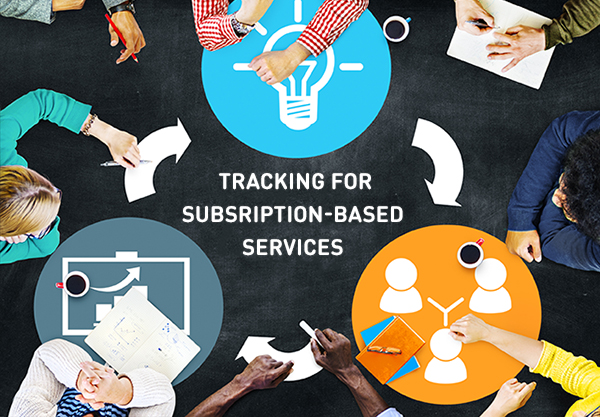Online marketing blog
Read about the latest industry trends and AdCumulus specials.
Get on the right track: Tracking for subscription-based services
By on 17. November 2015.

Have you ever thought about why is it so important to reliably track users on subscription-based services? In this week’s blog we will discuss why accurate and timely way to manage and track subscriptions is a win-win situation for both affiliates and service providers. For starters, let us define what subscription-based services are, and then proceed to tracking.
It could be a subscription to…
As the name suggests, they are services that require customer subscription. After the first subscription, customers prolong it on a weekly or monthly basis, depending on the payout cycle setup. In affiliate marketing, subscription-based services enable affiliate programs and networks to offer affiliates a payout for each new user that is brought to the service.
Take mobile services, for example. Service providers keep track of their users and know whether a certain user was granted the rights to particular content. It could be a subscription to live tubes, interesting content like horoscope, membership on dating sites, or maybe the access to a ringtone library. The most used subscription-based service is video on demand (or VOD).
How to track users?
There are two tracking models that our AdCumulus affiliate tracking system can easily support: one-time CPA model and lifetime revenue share. In the first model, affiliates earn a one-time payout for each new user they bring to the service. The system monitors rebilling, that is, users’ entering in every new payout cycle. But it will also recognize that it was all part of one session, so that all actions can be connected to the same user.
How to identify users who subscribed to a service, and continued prolonging it? They can be looked up by a username if they have logged in on a service. If they haven’t, tracking is usually based on cookies or identification methods like those employed when paying the service by direct operator billing/credit cards/SMS/other ways that ensure tracking.
Who earns more money?
In the one-time CPA model, it is common for the affiliate to earn more than the service provider does. Users pay a certain amount to subscribe to the service, yet it is the affiliates who end up being better off.
Although it might seem financially ineffective at first, there is logic behind it. The user will pay a certain amount in the next payout cycle, which will cover service provider’s investment, and with another payment in the following (third) cycle, service provider gets pure profit.
Taking this into account, it is obvious why service providers try hard to retain their users as long as possible.
Lifetime revenue share
The second tracking model is based on the lifetime revenue share. In this model, affiliates get a revenue share as long as users stay subscribed to a service. On the one hand, this model is a great possibility for affiliates to earn continuously; the payout is lower than in the one-time CPA model, though.
Consequently, it is in affiliates’ interest to keep users subscribed as long as possible. Therefore, they need to make sure the sent traffic is high-quality.
A 2nd best alternative
AdCumulus’ solution isn’t the only tracking solution. So how does the tracking process work on other affiliate tracking platforms? Two offers have to be created on affiliate software. The first offer is created to track first-time subscriptions, and the second one to track all rebillings.
The problem is obvious – it’s not only that making two offers isn’t the optimal solution, affiliates have to be really careful not to send traffic to the wrong one, too. There was desperate need for a more practical solution.
The solution was to separate the tracking models into the mentioned one-time CPA model and lifetime revenue share.
Tracking risks
However, there are risks in the whole tracking process. The biggest one is fraud. In this case, affiliates pretend to be users and register on a service, invest small, earn big, and simply unsubscribe before the next payment cycle starts. It is not easy to recognize fraud; unless affiliates get greedy. In that case, unusual changes appear in statistics.
The other risk is connected to incentivized traffic. In this case, affiliates or publishers pay the users or provide them with other benefits in order to encourage them to install an application, subscribe to a service or buy a product, for example.
But the imposed encouragement is usually not enough and does not have the same effect as when users themselves decide to take action. Chances are they will probably unsubscribe after receiving the benefits promised.
Tracking different events
There is also a possibility of tracking different events, as part of one offer. Tracking can be done by affiliate or by event. For example, an event can be the installation of an app, but additional actions that can be tracked are purchasing, subscribing or signing up.
Whichever action the user takes within the application, it can be tracked as a specific event. AdCumulus affiliate system also gives insight into whether the tracking is by affiliate or event, revenue and payout.
First-time subscription and renewals
The biggest tracking problem is the differentiation between a first-time subscription and a renewal (customer payment for a new subscription period). The solution for this exact issue is the AdCumulus affiliate software’s forte.
It is important to make a difference not just for the sake of statistics, but also because affiliates are mostly paid using the one-time CPA model. Bearing in mind how the model works, the difference between the two has got to be noted; otherwise the whole tracking process will be dead in the water.





Comments